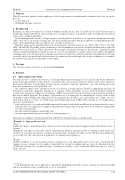Page 547 - SAIT Compendium 2016 Volume2
P. 547
IN 63 (2) Income Tax acT: InTeRPReTaTIon noTes IN 63 (2)
1. Purpose
This Note provides guidance on the application of the foreign currency translation rules contained in the Act, except for those in –
• section 24I; and
• the Eighth Schedule to the Act.
2. Background
Residents are subject to normal tax on their worldwide taxable income, that is, taxable income derived from sources within and outside South Africa. A person that is not a resident is subject to normal tax only on taxable income derived from a source within South Africa.
In determining taxable income, foreign currency amounts must be translated to an equivalent amount in rand using either a spot rate or an average exchange rate. The Act generally prescribes which rate must be used depending upon the nature of the underlying transaction and the type of taxpayer involved.
This Note discusses the translation rules in sections 6quat(4) and (4A), 6quin(4), 9A, 9D(6), 25D, 35A(5), 47J, 49H, 50H, 51H and 64N. Depending on the circumstances, the determination of a person’s normal tax liability may require the application of more than one of these provisions. For example, a natural person may use the spot rate to translate foreign currency amounts includable in taxable income for a year of assessment in accordance with section 25D(1). In addition, assuming some of the foreign currency amounts were from a foreign source and the natural person quali ed for a foreign tax rebate on the foreign tax paid on that income, the natural person would apply the average exchange rate to translate the amount of foreign tax to rand under section 6quat.
3. The law
The relevant sections of the Act are quoted in the Annexure. 4. General
4.1 Spot rate [section 1(1)]
The term ‘spot rate’ is de ned in section 1(1) as the appropriate quoted exchange rate at a speci c time by any authorised dealer in foreign exchange for the delivery of currency. The term is used extensively in the various rules, which are discussed in this Note, for translating foreign currency amounts to rand. An ‘appropriate’ spot rate will depend on the facts and circumstances of the particular case.
On a strictly technical basis, amounts received or accrued in a foreign currency should, in applying the spot rate, be translated to rand at the appropriate buying rate of exchange, while expenditure or losses incurred should be translated to rand at the appropriate selling rate of exchange. SARS is aware that for practical reasons some persons do not follow this strict technical approach. For example, a person may use a closing spot rate comprising the average of the closing telegraphic transfer buying and selling rates for the particular day. In other cases a person may use a single rate for a short period such as a week to record all transactions during that period. SARS will accept the use of an approximate spot rate* provided that –
• it does not give rise to a result which differs materially from the result which would have been obtained had the correct daily spot rate been applied, for example, if the particular foreign currency in question does not uctuate signi cantly over the relevant period;
• the same method is applied consistently; and
• the same approximate spot rate is used for accounting purposes.
Generally, accounting records prepared in line with IAS 21 should yield an acceptable result.
Example 1 – Appropriate spot rate
Facts:
ABC (Pty) Ltd is a manufacturer that orders most of its raw materials from 12 suppliers in the United States twice a month.
During the year under review staff focussed on growing the business and neglected the accounting records. At the end of the year a decision was taken to calculate an annual average exchange rate and to record all transactions during the year at that rate. The same basis was applied for accounting and tax purposes.
Result:
SARS is unlikely to accept an annual average exchange rate as an approximate spot rate because even though the annual average exchange rate was applied consistently for tax and accounting purposes, given the uctuation in the USD/rand exchange rate, an annual average exchange rate is likely to give a materially different result to a correct daily spot rate.
* An approximate spot rate is different to and must be distinguished from the average exchange rate discussed in 4.2 which is an annual average calculated for a year of assessment.
saIT comPendIum oF Tax LegIsLaTIon VoLume 2 539


